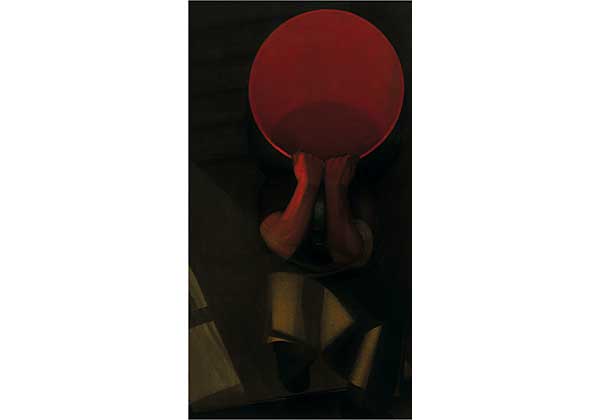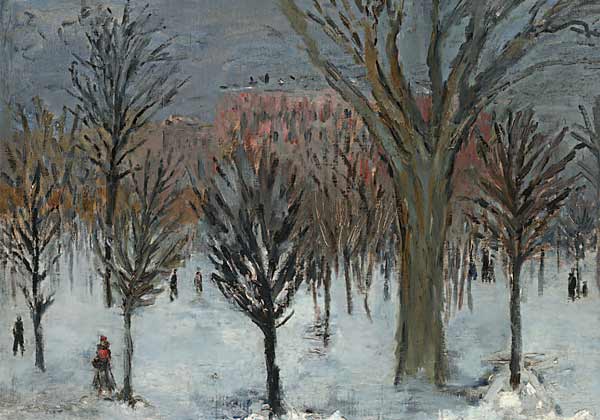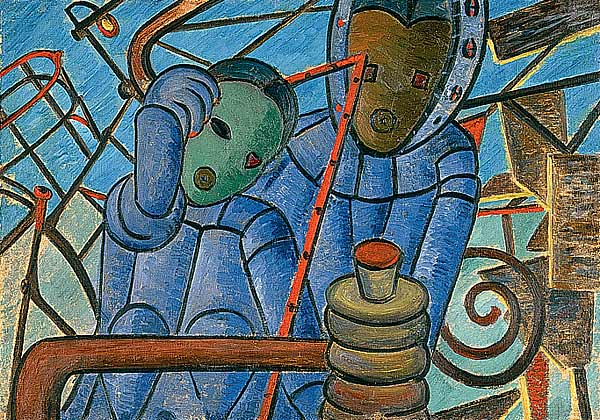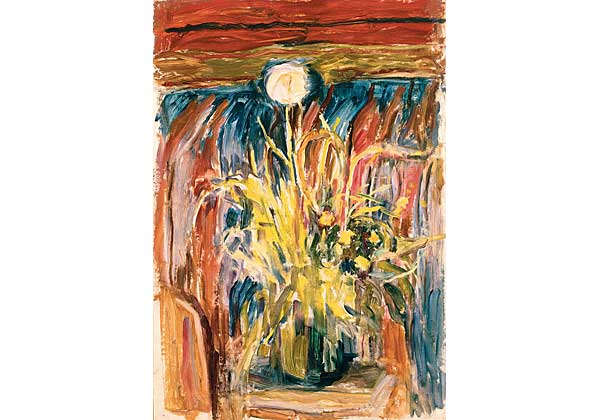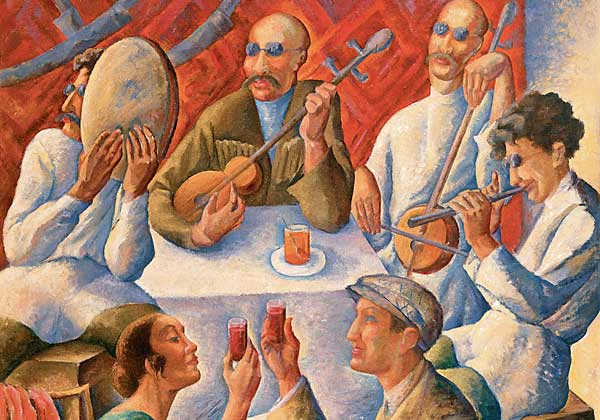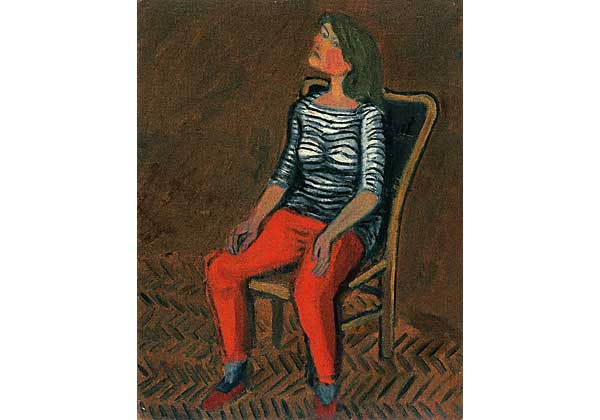Consulting коллекция Стеллы и Вадима Аминовых
-
-
Chirkov, Anton Nikolayevich
(b. 1902 Village of Napolny Vyas, Penza guberniya – d. 1946 village of Zhegalovo, Moscow region)
Painter and graphic artist
1920 – Joined the Penza Art School, where he studied in A. Shturman’s studio.
1922 – Moved to Moscow and was enrolled in Vkhutemas (the Higher Art and Technical Studios), where he studied in the studios of A. Osmyorkin, I. Mashkov and P. Konchalovsky.
1925 – Had his work “Loaves of Bread” shown at the World’s Fair in Paris.
1926 – Took part in an exhibition of the Bytiye (Existence) association of artists.
1927 – Graduated from Vkhutein (former Vkhutemas), took part in an exhibition of the Krylo (Wing) association.
1928 – Took part in an exhibition marking the tenth anniversary of the Bolshevik revolution and in an exhibition of the Moscow Artists Society (OMKh), taught at the Ryazan Art College.
1930 – Began to teach at the Memory of 1905 Moscow Regional Art School (MOKhU).
1931 – Sent to the northern Russian city of Murmansk for a working visit that resulted in one of his best-known works, “Northern Venus.”
1937 – Personal exhibitions at the MOKhU and the Hammer and Sickle cultural center in Moscow.
1941 – Was drafted into the armed forces.
1942 – Demobilized, had a personal exhibition at the Artists House at 15 Verkhnyaya Maslovka Street.
1945–1946 – Painted frescoes in the Church of St. Nicholas in Zhegalovo, Moscow region.
-
Chirkov, Anton Nikolayevich
(b. 1902 Village of Napolny Vyas, Penza guberniya – d. 1946 village of Zhegalovo, Moscow region)
Painter and graphic artist
1920 – Joined the Penza Art School, where he studied in A. Shturman’s studio.
1922 – Moved to Moscow and was enrolled in Vkhutemas (the Higher Art and Technical Studios), where he studied in the studios of A. Osmyorkin, I. Mashkov and P. Konchalovsky.
1925 – Had his work “Loaves of Bread” shown at the World’s Fair in Paris.
1926 – Took part in an exhibition of the Bytiye (Existence) association of artists.
1927 – Graduated from Vkhutein (former Vkhutemas), took part in an exhibition of the Krylo (Wing) association.
1928 – Took part in an exhibition marking the tenth anniversary of the Bolshevik revolution and in an exhibition of the Moscow Artists Society (OMKh), taught at the Ryazan Art College.
1930 – Began to teach at the Memory of 1905 Moscow Regional Art School (MOKhU).
1931 – Sent to the northern Russian city of Murmansk for a working visit that resulted in one of his best-known works, “Northern Venus.”
1937 – Personal exhibitions at the MOKhU and the Hammer and Sickle cultural center in Moscow.
1941 – Was drafted into the armed forces.
1942 – Demobilized, had a personal exhibition at the Artists House at 15 Verkhnyaya Maslovka Street.
1945–1946 – Painted frescoes in the Church of St. Nicholas in Zhegalovo, Moscow region.
-
(b. 1906 Grodno – d. 1984 Moscow)
Painter and graphic artist
1919–1923 – Studied at the private studios of F. Rerberg and A. Miganadjian in Moscow and audited classes at the First State Free Art Studios under I. Mashkov.
1924–1926 – Studied at Vkhutein [The Higher Art and Technical Institute] in Leningrad under K. Petrov-Vodkin.
1927–1929 – Studied at Vkhutein in Moscow under D. Shterenberg.
Took part in exhibitions beginning in 1928, including: 1928 – Fourth Exhibition of Paintings, Drawings, and Sculpture by OST [Society for Easel Painting]; 1929 – USSR Art Exhibition in New York; 1931 – art exhibition in Paris; 1938 – the Soviet exhibition in London; 1966 – first personal exhibition in Moscow; 1978 – second personal exhibition in Moscow.
From 1931 on – Worked as a book illustrator and designer, designed stage scenery for theaters in Moscow, Kiev, Odessa, and Rybinsk.
From 1944 on – Worked on the TASS Windows propaganda posters, as well as in various publishing houses and as an art director of Vokrug Sveta [Around the World] magazine.
1959 – Awarded a silver medal at the Leipzig Book Fair for his work on In Praise of Folly by Erasmus of Rotterdam.
“The thought that a painting’s only value is in itself, is alien to me. I see its meaning in the images and associations it provokes; the more numerous and various they are, the more necessary the painting is. It also reflects the humans’ great community and continuity that is reflected in the very fact that we, people of the second half of the 20th century, who fly gigantic airplanes, travel in space and land on the Moon, can find pleasure in a simple and beautiful sight of a plate filled with peaches with tender velvety skin, with shades of pink and blue, or a white jar with blue ornaments and a bouquet of flowers — the same sight that might have delighted an artist who lived three centuries ago, wore a powdered wig and silk trousers, believed in God and honoured his King.”
Leonid Zusman, 1978
S.I. Balashov. Leonid Zusman. M.: Agey Tomesh, 2004. P. 16. (Novaya istoriya iskusstva [New History of Art]).
-
(b. 1906 Grodno – d. 1984 Moscow)
Painter and graphic artist
1919–1923 – Studied at the private studios of F. Rerberg and A. Miganadjian in Moscow and audited classes at the First State Free Art Studios under I. Mashkov.
1924–1926 – Studied at Vkhutein [The Higher Art and Technical Institute] in Leningrad under K. Petrov-Vodkin.
1927–1929 – Studied at Vkhutein in Moscow under D. Shterenberg.
Took part in exhibitions beginning in 1928, including: 1928 – Fourth Exhibition of Paintings, Drawings, and Sculpture by OST [Society for Easel Painting]; 1929 – USSR Art Exhibition in New York; 1931 – art exhibition in Paris; 1938 – the Soviet exhibition in London; 1966 – first personal exhibition in Moscow; 1978 – second personal exhibition in Moscow.
From 1931 on – Worked as a book illustrator and designer, designed stage scenery for theaters in Moscow, Kiev, Odessa, and Rybinsk.
From 1944 on – Worked on the TASS Windows propaganda posters, as well as in various publishing houses and as an art director of Vokrug Sveta [Around the World] magazine.
1959 – Awarded a silver medal at the Leipzig Book Fair for his work on In Praise of Folly by Erasmus of Rotterdam.
“The thought that a painting’s only value is in itself, is alien to me. I see its meaning in the images and associations it provokes; the more numerous and various they are, the more necessary the painting is. It also reflects the humans’ great community and continuity that is reflected in the very fact that we, people of the second half of the 20th century, who fly gigantic airplanes, travel in space and land on the Moon, can find pleasure in a simple and beautiful sight of a plate filled with peaches with tender velvety skin, with shades of pink and blue, or a white jar with blue ornaments and a bouquet of flowers — the same sight that might have delighted an artist who lived three centuries ago, wore a powdered wig and silk trousers, believed in God and honoured his King.”
Leonid Zusman, 1978
S.I. Balashov. Leonid Zusman. M.: Agey Tomesh, 2004. P. 16. (Novaya istoriya iskusstva [New History of Art]).
-
-
Sofronova (Safronova), Antonina Fyodorovna
(b. 1892 Village of Droskovo, Oryol guberniya – d. 1966 Moscow)
Painter and graphic artist
1910–1913 – Studied in Moscow at the studio of F. Rerberg.
1913–1917 – At I. Mashkov’s studio.
1920–1921 – Taught at the State Free Art Studios in Tver. Author of several articles on the theory of new art.
Took part in exhibitions beginning in 1914, including: 1914 – the Jack of Diamonds group; 1917 – the World of Art group and the Moscow Association of Artists; 1925 – the International Exhibition of Modern Decorative and Industrial Arts in Paris; 1931 – the Thirteen group; 1962 – personal exhibition in Moscow’s Central House of Writers.
1923 – Designed the cover for Nikolai Tarabukin’s book From Easel to Machine.
1931 – Member of the Thirteen group.
“Since 1926 [Sofronova] began painting scenes of Moscow in oil. She loved to walk down Moscow’s streets and frequently took promenades along the Moskva River. All of these places were not far from where she lived, in BolshoyAfanasyevsky Lane, located between the Arbat and Prechistenka Street. <…> As Sofronova strolled along, she would make little sketches with faint pencil marks and indications of color, or sometimes simply remembered what she saw — she had practiced this hard while living in Droskovo. Returning home, she would paint the scene preliminarily in watercolors with whitewash (eventually producing a series of such paintings). In selecting which motifs of the city to paint, Sofronova was mostly attracted to those views which had a receding line. For example, she loved to paint riverfronts, city streets, and alley sidewalks. Her paintings were spacious, with lots of sky, river views, and trees with sparse foliage; the light was soft, with no sharply defined shadows.”
Irina Yevstafieva, Antonina Sofronova
Khudozhniki gruppy Trinadtsat. Iz istorii khudozhestvennoy zhizni 1920-1930-kh gg. [The Artists of the Thirteen group: From the History of Art in the 1920s—1930s]. M.: Sovetsky Khudozhnik, 1985. P. 193.
-
Sofronova (Safronova), Antonina Fyodorovna
(b. 1892 Village of Droskovo, Oryol guberniya – d. 1966 Moscow)
Painter and graphic artist
1910–1913 – Studied in Moscow at the studio of F. Rerberg.
1913–1917 – At I. Mashkov’s studio.
1920–1921 – Taught at the State Free Art Studios in Tver. Author of several articles on the theory of new art.
Took part in exhibitions beginning in 1914, including: 1914 – the Jack of Diamonds group; 1917 – the World of Art group and the Moscow Association of Artists; 1925 – the International Exhibition of Modern Decorative and Industrial Arts in Paris; 1931 – the Thirteen group; 1962 – personal exhibition in Moscow’s Central House of Writers.
1923 – Designed the cover for Nikolai Tarabukin’s book From Easel to Machine.
1931 – Member of the Thirteen group.
“Since 1926 [Sofronova] began painting scenes of Moscow in oil. She loved to walk down Moscow’s streets and frequently took promenades along the Moskva River. All of these places were not far from where she lived, in BolshoyAfanasyevsky Lane, located between the Arbat and Prechistenka Street. <…> As Sofronova strolled along, she would make little sketches with faint pencil marks and indications of color, or sometimes simply remembered what she saw — she had practiced this hard while living in Droskovo. Returning home, she would paint the scene preliminarily in watercolors with whitewash (eventually producing a series of such paintings). In selecting which motifs of the city to paint, Sofronova was mostly attracted to those views which had a receding line. For example, she loved to paint riverfronts, city streets, and alley sidewalks. Her paintings were spacious, with lots of sky, river views, and trees with sparse foliage; the light was soft, with no sharply defined shadows.”
Irina Yevstafieva, Antonina Sofronova
Khudozhniki gruppy Trinadtsat. Iz istorii khudozhestvennoy zhizni 1920-1930-kh gg. [The Artists of the Thirteen group: From the History of Art in the 1920s—1930s]. M.: Sovetsky Khudozhnik, 1985. P. 193.
-
-
Yermilova-Platova, Yefrosiniya Fedoseyevna
(b. 1895 Village of Kamenka, Tavricheskaya guberniya – d. 1974 Moscow)
Painter, graphic artist
1914 – Entered the Moscow University (Department of History and Philology).
1914–1916 – Studied drawing under K. Yuon and I. Dudin.
1917–1918 – Attended I. Mashkov’s workshop.
1919 – Participated in the founding of an artistic studio, museum and poster workshop in Nikopol.
1919–1921 – Worked in the art section of the Crimean National Department of Education in Simferopol under Ya. Tugendhold.
Took part in exhibitions beginning in 1919, including: 1919 – exhibition of Kherson artists; 1932 – Artists of the RSFSR [Russian Soviet Federative Socialist Republic] During the Past 15 Years (Leningrad); 1934 – exhibition at the Club of Master Artists (Moscow) together with her husband, F. Platov; 1939, 1944 – personal exhibitions.
1949 – Expelled from the MOSKh [Moscow Artists’ Union].
1992 – posthumous personal exhibition at the Kuntsevo Exhibition Hall (Moscow).
“I don’t remember the exact year, but the exhibition by Goncharova, Larionov, and Burlyuk in Kherson left an indelible impression on my artwork for the rest of my life. I always really enjoyed primitivists such as Giotto, Pieter Bruegel, and contemporary French painters.”
The sources of her series of paintings Faces and Streets, At the Barber Shop, and Themes from Old Russian Frescoes are evident: folk painting, sign boards, popular prints, and icons. But these merely served as starting points for her work. c.> The unlimited fantasy, spontaneous self-expression, and organic primitivism of Yermilova-Platova sewed as a trustworthy antidote to the poison of stylization and even imitation. Her motto was “I paint everything I love.”
“In my childhood, I looked after flowers.” Flowers in the field and in the garden, exotic flowers, later became the dominant motif of her still lifes.
“The beauty of the Dnieper River has left its imprint on me for my entire life: its extraordinary high waters, riding in rowboats, sailboats and other small crafts into the city of Nikopol during both stormy and calm weather.” The word “imprint” seems to be very precise, for it is unlikely that Yermilova-Flatova painted her Kamenka-on-the-Dnieper scenes directly from life, year in, year out, in spring and in fall. It rather seems that she was traveling along the paths ingrained in her memory, again and again experiencing the feeling of being on the boundless waters or steppe, with the sky overhead. Her space is magnetic; it is made of “flying matter,” the condensation and dispersal of light, and is organized “by lines that express the crystal clarity of the details and a slightly indistinct landscape.” The artist’s ideal is “the Japanese linethat can be hard like metal and soft like down. It conveys a calm balance and a swift motion. The line is maintained both on the plane and in space.”
O. Roytenberg. Neuzheli kto-to vspomnit, chto my byli… Iz istorii khudozhestvennoy zhizni. 1925—1935 [Can It be that Someone Remembers that we Existed… From the History of Artistic Life: 1925—1935]. M.: Galart, 2004. Pp. 370, 372—373.
-
Yermilova-Platova, Yefrosiniya Fedoseyevna
(b. 1895 Village of Kamenka, Tavricheskaya guberniya – d. 1974 Moscow)
Painter, graphic artist
1914 – Entered the Moscow University (Department of History and Philology).
1914–1916 – Studied drawing under K. Yuon and I. Dudin.
1917–1918 – Attended I. Mashkov’s workshop.
1919 – Participated in the founding of an artistic studio, museum and poster workshop in Nikopol.
1919–1921 – Worked in the art section of the Crimean National Department of Education in Simferopol under Ya. Tugendhold.
Took part in exhibitions beginning in 1919, including: 1919 – exhibition of Kherson artists; 1932 – Artists of the RSFSR [Russian Soviet Federative Socialist Republic] During the Past 15 Years (Leningrad); 1934 – exhibition at the Club of Master Artists (Moscow) together with her husband, F. Platov; 1939, 1944 – personal exhibitions.
1949 – Expelled from the MOSKh [Moscow Artists’ Union].
1992 – posthumous personal exhibition at the Kuntsevo Exhibition Hall (Moscow).
“I don’t remember the exact year, but the exhibition by Goncharova, Larionov, and Burlyuk in Kherson left an indelible impression on my artwork for the rest of my life. I always really enjoyed primitivists such as Giotto, Pieter Bruegel, and contemporary French painters.”
The sources of her series of paintings Faces and Streets, At the Barber Shop, and Themes from Old Russian Frescoes are evident: folk painting, sign boards, popular prints, and icons. But these merely served as starting points for her work. c.> The unlimited fantasy, spontaneous self-expression, and organic primitivism of Yermilova-Platova sewed as a trustworthy antidote to the poison of stylization and even imitation. Her motto was “I paint everything I love.”
“In my childhood, I looked after flowers.” Flowers in the field and in the garden, exotic flowers, later became the dominant motif of her still lifes.
“The beauty of the Dnieper River has left its imprint on me for my entire life: its extraordinary high waters, riding in rowboats, sailboats and other small crafts into the city of Nikopol during both stormy and calm weather.” The word “imprint” seems to be very precise, for it is unlikely that Yermilova-Flatova painted her Kamenka-on-the-Dnieper scenes directly from life, year in, year out, in spring and in fall. It rather seems that she was traveling along the paths ingrained in her memory, again and again experiencing the feeling of being on the boundless waters or steppe, with the sky overhead. Her space is magnetic; it is made of “flying matter,” the condensation and dispersal of light, and is organized “by lines that express the crystal clarity of the details and a slightly indistinct landscape.” The artist’s ideal is “the Japanese linethat can be hard like metal and soft like down. It conveys a calm balance and a swift motion. The line is maintained both on the plane and in space.”
O. Roytenberg. Neuzheli kto-to vspomnit, chto my byli… Iz istorii khudozhestvennoy zhizni. 1925—1935 [Can It be that Someone Remembers that we Existed… From the History of Artistic Life: 1925—1935]. M.: Galart, 2004. Pp. 370, 372—373.
-
Sergei Mikhailovich Romanovich
(1894, Moscow – 1968, Moscow)
Painter and graphic artist
1894 was born on September 11 in Moscow to the family of Mikail Mikailovich Romanovich, an officer in the Opekunsky Soviet (Board of Trustees) under the Empress’s personal direction
1909 enrolled in the general education department of the Moscow School of Painting, Sculpture and Architecture (MUZhVZ)
1912 studied in the painting department of MUZhVZ. S. M. Romanovich’s instructors at the school were A. Arkipov, A. Baksheev, K. Korovin, P. Kuznetsov, S. Malyutin and L. Pasternak. In that same year he joined M. Larionov’s Krug Soratnikov (Circle of Brothers-in-Arms)
1913 participated in an exhibition by M. Larionov’s group Mishen (Target)
1914 participated in the exhibition No. 4. After the start of the war, S. M. Romanovich was drafted to the army but was soon discharged.
1915 gave a solo exhibition at MUZhVZ at which S. M. Romanovich presented his abstract works
1918 completed his education at MUZhVZ and taught at Proletkult’s Moscow fine arts studio
1920 began teaching at the Voronezh Higher Art and Technical Studios (Vorkutemas)
1921 joined the artists’ and poets’ federation Art is Life (Makovets). Took part in the federation’s exhibitions in 1922, 1924 and 1925.
1922 became a Vkutemas professor in Moscow; in that same year he published an article titled “On Realism” in the second issue of the journal Makovets.
1928 joined the Society of Moscow Artists (OMKh)
1929 participated in an exhibition by the artistic association The Four Arts; beginning in this year he taught painting at Rabfak (Workers’ Faculty) in Moscow
1935 began working in the USSR Architecture Academy’s monumental painting studio where he remained until 1948
1950 was an instructor in the ornamental department of the Moscow Higher School of Arts and Industry
1968 died in Moscow on November 21.
-
-
(b. 1906 Grodno – d. 1984 Moscow)
Painter and graphic artist
1919–1923 – Studied at the private studios of F. Rerberg and A. Miganadjian in Moscow and audited classes at the First State Free Art Studios under I. Mashkov.
1924–1926 – Studied at Vkhutein [The Higher Art and Technical Institute] in Leningrad under K. Petrov-Vodkin.
1927–1929 – Studied at Vkhutein in Moscow under D. Shterenberg.
Took part in exhibitions beginning in 1928, including: 1928 – Fourth Exhibition of Paintings, Drawings, and Sculpture by OST [Society for Easel Painting]; 1929 – USSR Art Exhibition in New York; 1931 – art exhibition in Paris; 1938 – the Soviet exhibition in London; 1966 – first personal exhibition in Moscow; 1978 – second personal exhibition in Moscow.
From 1931 on – Worked as a book illustrator and designer, designed stage scenery for theaters in Moscow, Kiev, Odessa, and Rybinsk.
From 1944 on – Worked on the TASS Windows propaganda posters, as well as in various publishing houses and as an art director of Vokrug Sveta [Around the World] magazine.
1959 – Awarded a silver medal at the Leipzig Book Fair for his work on In Praise of Folly by Erasmus of Rotterdam.
“The thought that a painting’s only value is in itself, is alien to me. I see its meaning in the images and associations it provokes; the more numerous and various they are, the more necessary the painting is. It also reflects the humans’ great community and continuity that is reflected in the very fact that we, people of the second half of the 20th century, who fly gigantic airplanes, travel in space and land on the Moon, can find pleasure in a simple and beautiful sight of a plate filled with peaches with tender velvety skin, with shades of pink and blue, or a white jar with blue ornaments and a bouquet of flowers — the same sight that might have delighted an artist who lived three centuries ago, wore a powdered wig and silk trousers, believed in God and honoured his King.”
Leonid Zusman, 1978
S.I. Balashov. Leonid Zusman. M.: Agey Tomesh, 2004. P. 16. (Novaya istoriya iskusstva [New History of Art]).





